2014 NISSAN ROGUE stop start
[x] Cancel search: stop startPage 419 of 442
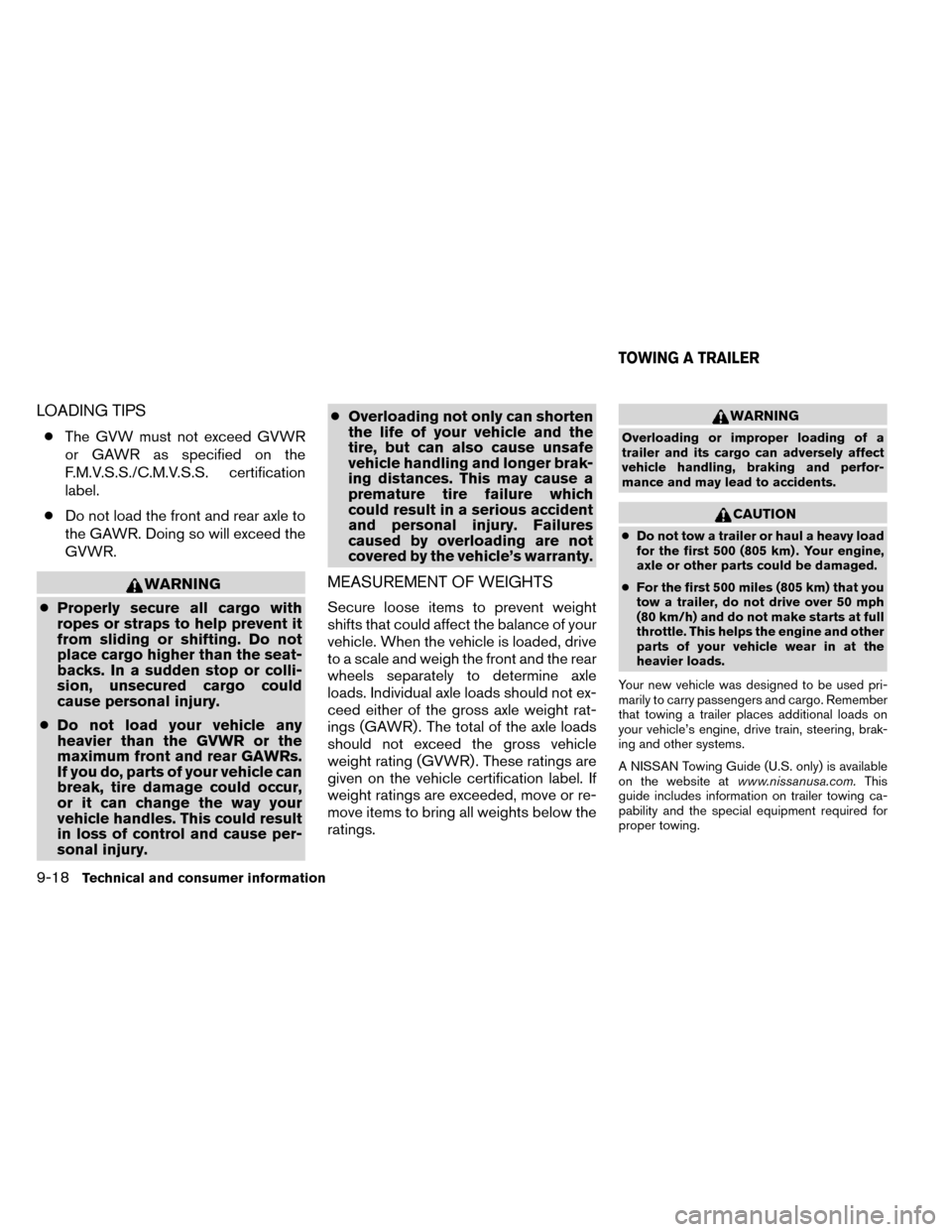
LOADING TIPS
●The GVW must not exceed GVWR
or GAWR as specified on the
F.M.V.S.S./C.M.V.S.S. certification
label.
● Do not load the front and rear axle to
the GAWR. Doing so will exceed the
GVWR.
WARNING
● Properly secure all cargo with
ropes or straps to help prevent it
from sliding or shifting. Do not
place cargo higher than the seat-
backs. In a sudden stop or colli-
sion, unsecured cargo could
cause personal injury.
● Do not load your vehicle any
heavier than the GVWR or the
maximum front and rear GAWRs.
If you do, parts of your vehicle can
break, tire damage could occur,
or it can change the way your
vehicle handles. This could result
in loss of control and cause per-
sonal injury. ●
Overloading not only can shorten
the life of your vehicle and the
tire, but can also cause unsafe
vehicle handling and longer brak-
ing distances. This may cause a
premature tire failure which
could result in a serious accident
and personal injury. Failures
caused by overloading are not
covered by the vehicle’s warranty.MEASUREMENT OF WEIGHTS
Secure loose items to prevent weight
shifts that could affect the balance of your
vehicle. When the vehicle is loaded, drive
to a scale and weigh the front and the rear
wheels separately to determine axle
loads. Individual axle loads should not ex-
ceed either of the gross axle weight rat-
ings (GAWR) . The total of the axle loads
should not exceed the gross vehicle
weight rating (GVWR) . These ratings are
given on the vehicle certification label. If
weight ratings are exceeded, move or re-
move items to bring all weights below the
ratings.
WARNING
Overloading or improper loading of a
trailer and its cargo can adversely affect
vehicle handling, braking and perfor-
mance and may lead to accidents.
CAUTION
● Do not tow a trailer or haul a heavy load
for the first 500 (805 km) . Your engine,
axle or other parts could be damaged.
● For the first 500 miles (805 km) that you
tow a trailer, do not drive over 50 mph
(80 km/h) and do not make starts at full
throttle. This helps the engine and other
parts of your vehicle wear in at the
heavier loads.
Your new vehicle was designed to be used pri-
marily to carry passengers and cargo. Remember
that towing a trailer places additional loads on
your vehicle’s engine, drive train, steering, brak-
ing and other systems.
A NISSAN Towing Guide (U.S. only) is available
on the website at www.nissanusa.com. This
guide includes information on trailer towing ca-
pability and the special equipment required for
proper towing.
TOWING A TRAILER
9-18Technical and consumer information
Page 426 of 442
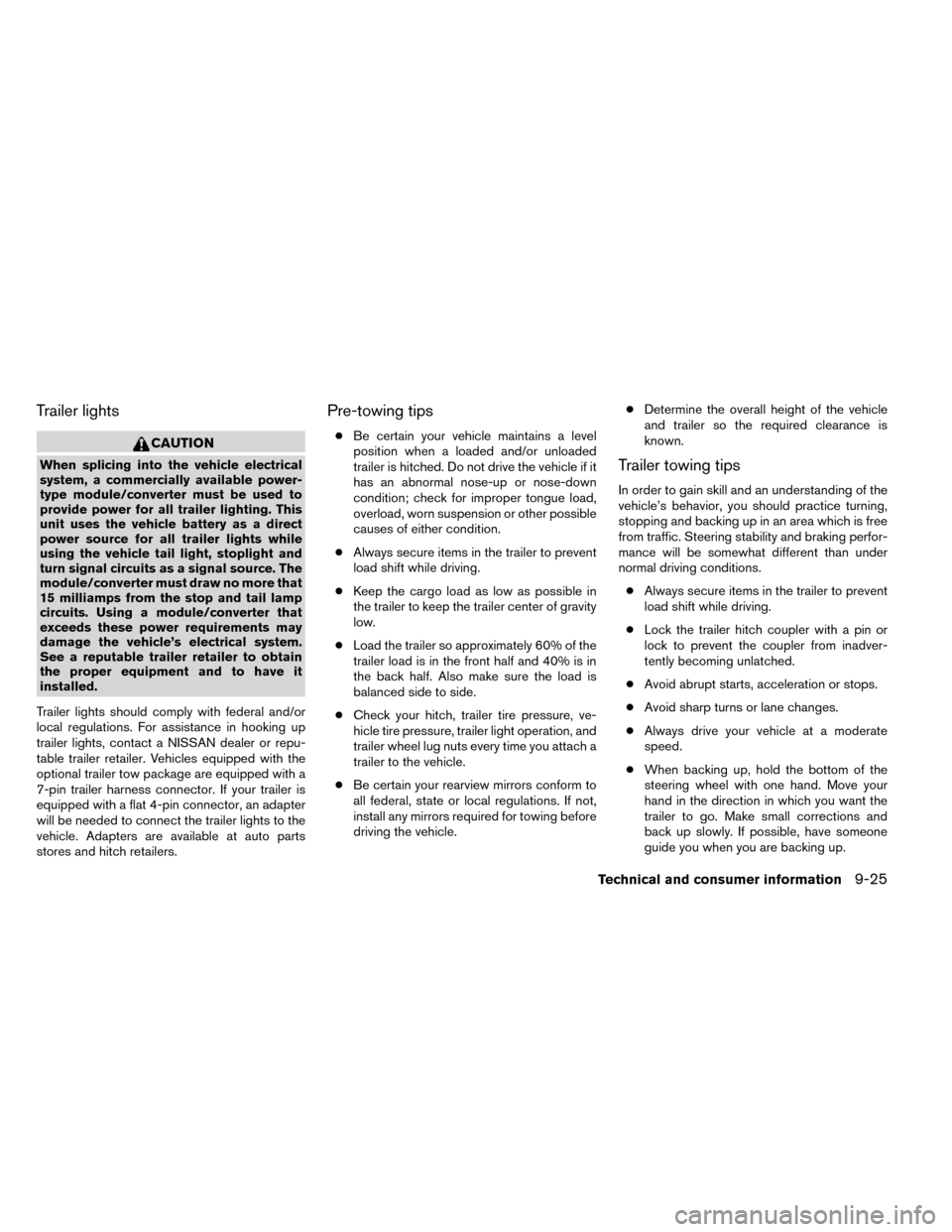
Trailer lights
CAUTION
When splicing into the vehicle electrical
system, a commercially available power-
type module/converter must be used to
provide power for all trailer lighting. This
unit uses the vehicle battery as a direct
power source for all trailer lights while
using the vehicle tail light, stoplight and
turn signal circuits as a signal source. The
module/converter must draw no more that
15 milliamps from the stop and tail lamp
circuits. Using a module/converter that
exceeds these power requirements may
damage the vehicle’s electrical system.
See a reputable trailer retailer to obtain
the proper equipment and to have it
installed.
Trailer lights should comply with federal and/or
local regulations. For assistance in hooking up
trailer lights, contact a NISSAN dealer or repu-
table trailer retailer. Vehicles equipped with the
optional trailer tow package are equipped with a
7-pin trailer harness connector. If your trailer is
equipped with a flat 4-pin connector, an adapter
will be needed to connect the trailer lights to the
vehicle. Adapters are available at auto parts
stores and hitch retailers.
Pre-towing tips
● Be certain your vehicle maintains a level
position when a loaded and/or unloaded
trailer is hitched. Do not drive the vehicle if it
has an abnormal nose-up or nose-down
condition; check for improper tongue load,
overload, worn suspension or other possible
causes of either condition.
● Always secure items in the trailer to prevent
load shift while driving.
● Keep the cargo load as low as possible in
the trailer to keep the trailer center of gravity
low.
● Load the trailer so approximately 60% of the
trailer load is in the front half and 40% is in
the back half. Also make sure the load is
balanced side to side.
● Check your hitch, trailer tire pressure, ve-
hicle tire pressure, trailer light operation, and
trailer wheel lug nuts every time you attach a
trailer to the vehicle.
● Be certain your rearview mirrors conform to
all federal, state or local regulations. If not,
install any mirrors required for towing before
driving the vehicle. ●
Determine the overall height of the vehicle
and trailer so the required clearance is
known.
Trailer towing tips
In order to gain skill and an understanding of the
vehicle’s behavior, you should practice turning,
stopping and backing up in an area which is free
from traffic. Steering stability and braking perfor-
mance will be somewhat different than under
normal driving conditions.
● Always secure items in the trailer to prevent
load shift while driving.
● Lock the trailer hitch coupler with a pin or
lock to prevent the coupler from inadver-
tently becoming unlatched.
● Avoid abrupt starts, acceleration or stops.
● Avoid sharp turns or lane changes.
● Always drive your vehicle at a moderate
speed.
● When backing up, hold the bottom of the
steering wheel with one hand. Move your
hand in the direction in which you want the
trailer to go. Make small corrections and
back up slowly. If possible, have someone
guide you when you are backing up.
Technical and consumer information9-25
Page 427 of 442
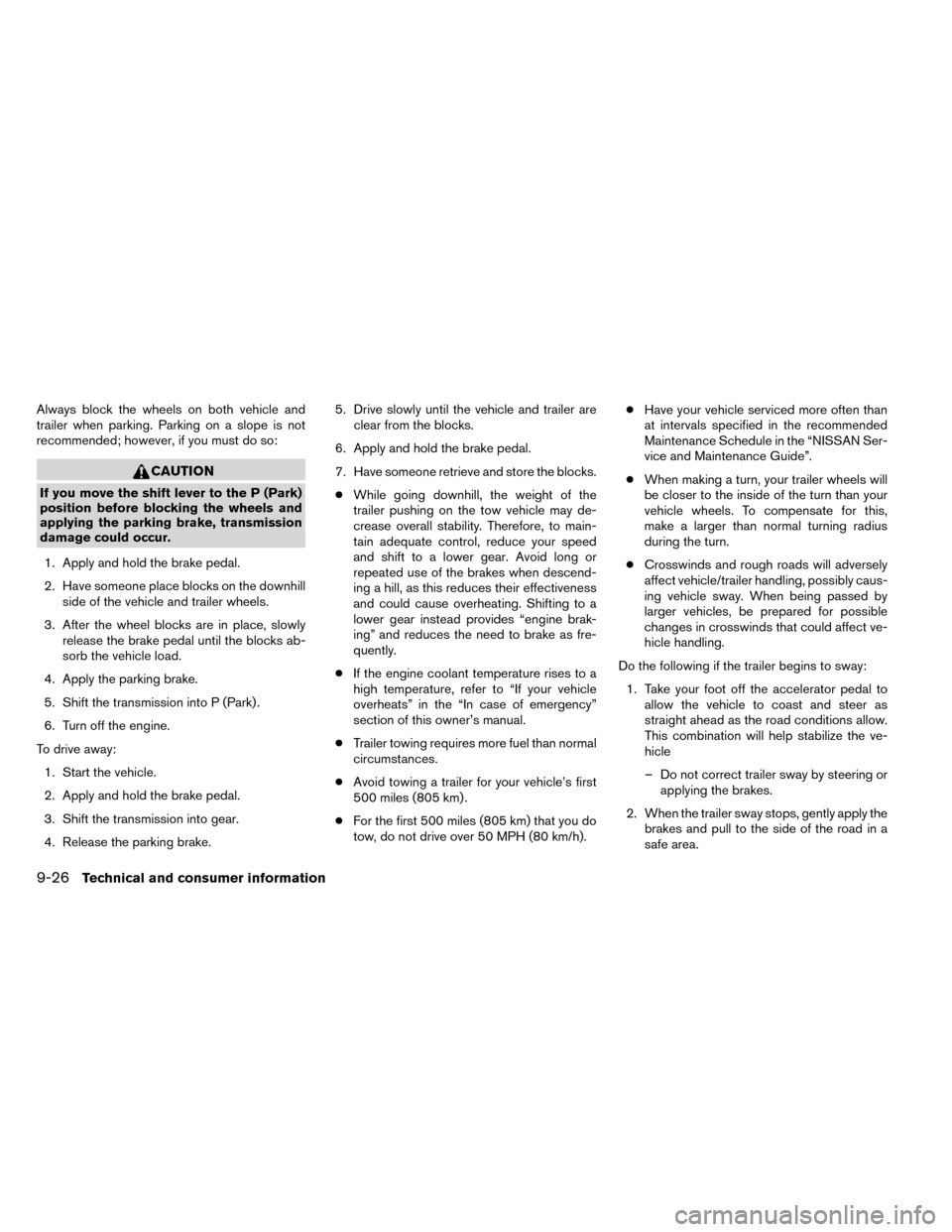
Always block the wheels on both vehicle and
trailer when parking. Parking on a slope is not
recommended; however, if you must do so:
CAUTION
If you move the shift lever to the P (Park)
position before blocking the wheels and
applying the parking brake, transmission
damage could occur.1. Apply and hold the brake pedal.
2. Have someone place blocks on the downhill side of the vehicle and trailer wheels.
3. After the wheel blocks are in place, slowly release the brake pedal until the blocks ab-
sorb the vehicle load.
4. Apply the parking brake.
5. Shift the transmission into P (Park) .
6. Turn off the engine.
To drive away: 1. Start the vehicle.
2. Apply and hold the brake pedal.
3. Shift the transmission into gear.
4. Release the parking brake. 5. Drive slowly until the vehicle and trailer are
clear from the blocks.
6. Apply and hold the brake pedal.
7. Have someone retrieve and store the blocks. ● While going downhill, the weight of the
trailer pushing on the tow vehicle may de-
crease overall stability. Therefore, to main-
tain adequate control, reduce your speed
and shift to a lower gear. Avoid long or
repeated use of the brakes when descend-
ing a hill, as this reduces their effectiveness
and could cause overheating. Shifting to a
lower gear instead provides “engine brak-
ing” and reduces the need to brake as fre-
quently.
● If the engine coolant temperature rises to a
high temperature, refer to “If your vehicle
overheats” in the “In case of emergency”
section of this owner’s manual.
● Trailer towing requires more fuel than normal
circumstances.
● Avoid towing a trailer for your vehicle’s first
500 miles (805 km) .
● For the first 500 miles (805 km) that you do
tow, do not drive over 50 MPH (80 km/h). ●
Have your vehicle serviced more often than
at intervals specified in the recommended
Maintenance Schedule in the “NISSAN Ser-
vice and Maintenance Guide”.
● When making a turn, your trailer wheels will
be closer to the inside of the turn than your
vehicle wheels. To compensate for this,
make a larger than normal turning radius
during the turn.
● Crosswinds and rough roads will adversely
affect vehicle/trailer handling, possibly caus-
ing vehicle sway. When being passed by
larger vehicles, be prepared for possible
changes in crosswinds that could affect ve-
hicle handling.
Do the following if the trailer begins to sway: 1. Take your foot off the accelerator pedal to allow the vehicle to coast and steer as
straight ahead as the road conditions allow.
This combination will help stabilize the ve-
hicle
– Do not correct trailer sway by steering or applying the brakes.
2. When the trailer sway stops, gently apply the brakes and pull to the side of the road in a
safe area.
9-26Technical and consumer information
Page 434 of 442
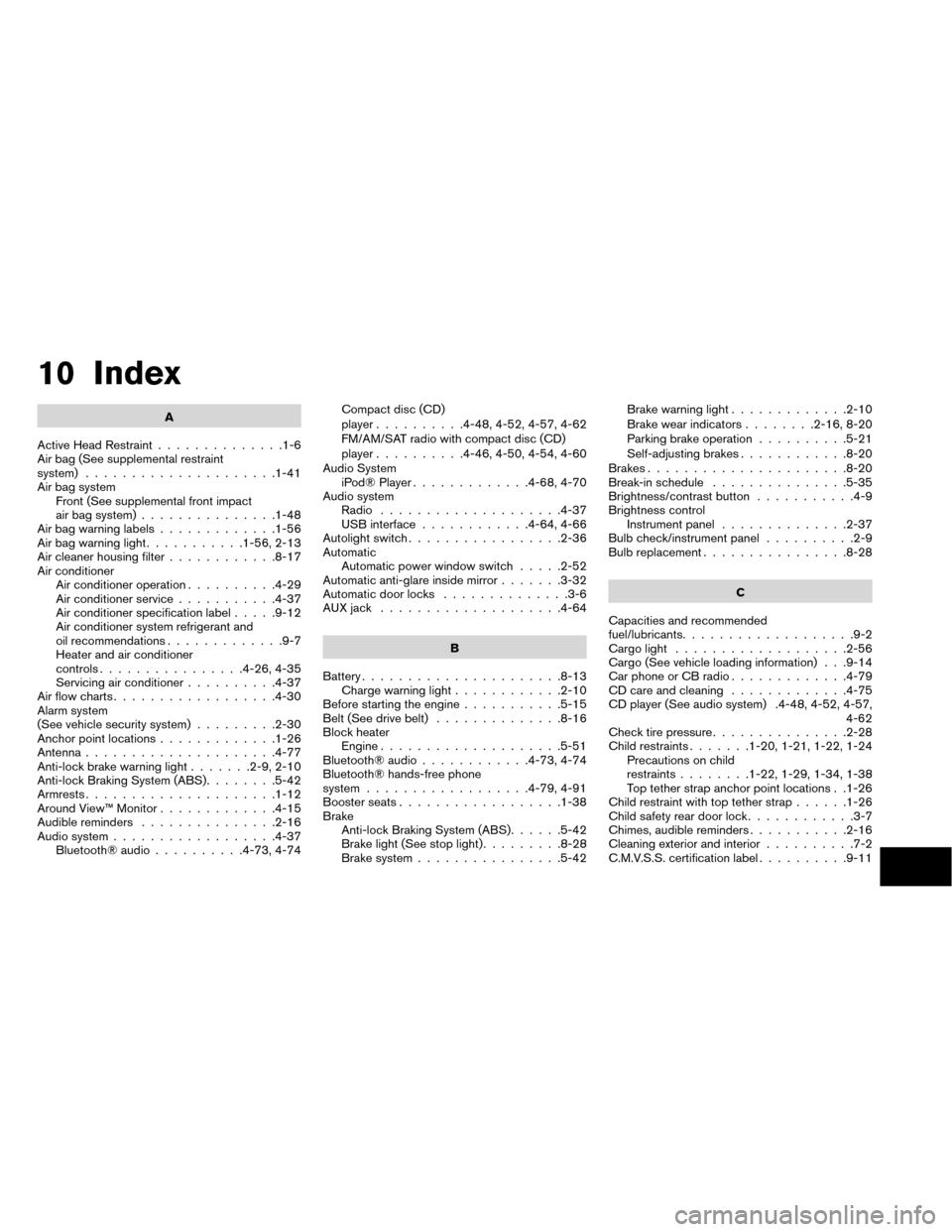
10 Index
A
Active Head Restraint ..............1-6
Air bag (See supplemental restraint
system) .....................1-41
Air bag system Front (See supplemental front impact
air bag system) ...............1-48
Air bag warning labels .............1-56
Airbagwarninglight...........1-56,2-13
Air cleaner housing filter ............8-17
Air conditioner Air conditioner operation ..........4-29
Air conditioner service ...........4-37
Air conditioner specification label .....9-12
Air conditioner system refrigerant and
oil recommendations .............9-7
Heater and air conditioner
controls................4-26,4-35
Servicing air conditioner ..........4-37
Airflowcharts..................4-30
Alarm system
(See vehicle security system) .........2-30
Anchor point locations .............1-26
Antenna .....................4-77
Anti-lock brake warning light .......2-9,2-10
Anti-lock Braking System (ABS) ........5-42
Armrests.....................1-12
Around View™ Monitor .............4-15
Audible reminders ...............2-16
Audio system ..................4-37
Bluetooth® audio ..........4-73,4-74 Compact disc (CD)
player
..........4-48,4-52,4-57,4-62
FM/AM/SAT radio with compact disc (CD)
player ..........4-46,4-50,4-54,4-60
Audio System iPod® Player .............4-68,4-70
Audio system Radio ....................4-37
USBinterface............4-64,4-66
Autolightswitch.................2-36
Automatic Automatic power window switch .....2-52
Automatic anti-glare inside mirror .......3-32
Automatic door locks ..............3-6
AUXjack ....................4-64
B
Battery......................8-13 Charge warning light ............2-10
Before starting the engine ...........5-15
Belt(Seedrivebelt) ..............8-16
Block heater Engine ....................5-51
Bluetooth® audio ............4-73,4-74
Bluetooth® hands-free phone
system ..................4-79,4-91
Booster seats ..................1-38
Brake Anti-lock Braking System (ABS) ......5-42
Brakelight(Seestoplight).........8-28
Brake system ................ 5-42Brakewarninglight.............2-10
Brake wear indicators
........2-16,8-20
Parking brake operation ..........5-21
Self-adjusting brakes ............8-20
Brakes ......................8-20
Break-in schedule ...............5-35
Brightness/contrast button ...........4-9
Brightness control Instrument panel ..............2-37
Bulb check/instrument panel ..........2-9
Bulb replacement ................8-28
C
Capacities
and recommended
fuel/lubricants ...................9-2
Cargolight ...................2-56
Cargo (See vehicle loading information) . . .9-14
Car phone or CB radio .............4-79
CD care and cleaning .............4-75
CD player (See audio system) .4-48, 4-52, 4-57, 4-62
Check tire pressure ...............2-28
Childrestraints.......1-20,1-21,1-22,1-24 Precautions on child
restraints........1-22,1-29,1-34,1-38
Top tether strap anchor point locations . .1-26
Childrestraintwithtoptetherstrap......1-26
Child safety rear door lock ............3-7
Chimes, audible reminders ...........2-16
Cleaning exterior and interior ..........7-2
C.M.V.S.S. certification label ..........9-11
Page 436 of 442

G
Garage door opener, HomeLink® Universal
Transceiver ....................2-57
Gascap .....................3-27
Gauge Engine coolant temperature gauge .....2-5
Fuel gauge ...................2-5
Odometer ...................2-4
Speedometer .................2-4
Tachometer ..................2-4
Trip odometer .................2-4
General maintenance ...............8-2
Glovebox.....................2-47
Gloveboxlock..................2-47
H
Hands-free phone system,
Bluetooth®................4-79,4-91
Hazard warning flasher switch ..........6-2
Headlight and turn signal switch ........2-35
Headlight control switch ............2-35
Headlights ....................8-27
Head restraints Active Head Restraint .............1-6
Headrests ...................1-6
Heated seats ...................2-39
Heater Heater and air conditioner
controls................4-26,4-35
Heater operation ...........4-28,4-36
Hill descent control switch ...........2-41
Hill descent control system ...........5-48Hill start assist system
..............5-49
HomeLink® Universal Transceiver .......2-57
Hood release ...................3-22
Hook Luggage hook ................2-48
Horn .......................2-38
I
Ignition switch ..................5-10
Ignition Switch Push-Button Ignition Switch ........5-12
Immobilizer system ......2-31,3-4,5-11,5-15
Important vehicle information label .......9-11
In-cabin microfilter ................8-18
Increasing fuel economy .............5-37
Indicator lights and audible reminders
(See warning/indicator lights and audible
reminders) .....................2-9
Inside automatic anti-glare mirror ........3-32
Inside mirror ...................3-31
Instrument brightness control ..........2-37
Instrument panel ...............0-6,2-2
Instrument panel dimmer switch ........2-37
Intelligent Key system Key operating range .............3-12
Key operation ................3-14
Mechanical key ................3-4
Remote keyless entry operation.......3-17
Troubleshooting guide ............3-20
Warning signals ...............3-20
Interiorlight....................2-55
iPod® Player ...............4-68,4-70
ISOFIX child restraints .............1-24 J
Jump starting ...................6-10
K
Keyfob battery replacement ...........
8-24
Keyless entry With Intelligent Key system
(See Intelligent Key system) .........3-17
Keyless entry system
(See remote keyless entry system) ........3-2
Keys, For Intelligent Key system ......3-2,3-11
L
Labels Air conditioner specification label .....9-12
C.M.V.S.S. certification label ........9-11
Emission control information label .....9-11
Engine serial number ............9-11
F.M.V.S.S. certification label .........9-11
Tire and Loading Information label .....9-12
Vehicle identification number (VIN) plate . .9-10
Warning labels (for SRS) ..........1-56
LATCH (Lower Anchors and Tethers for CHildren)
System ......................1-24
License plate Installing the license plate ..........9-13
Liftgate......................3-23
Lift gate release .................3-26
Light Airbagwarninglight.........1-56,2-13
Brakelight(Seestoplight).........8-28
10-3
Page 438 of 442
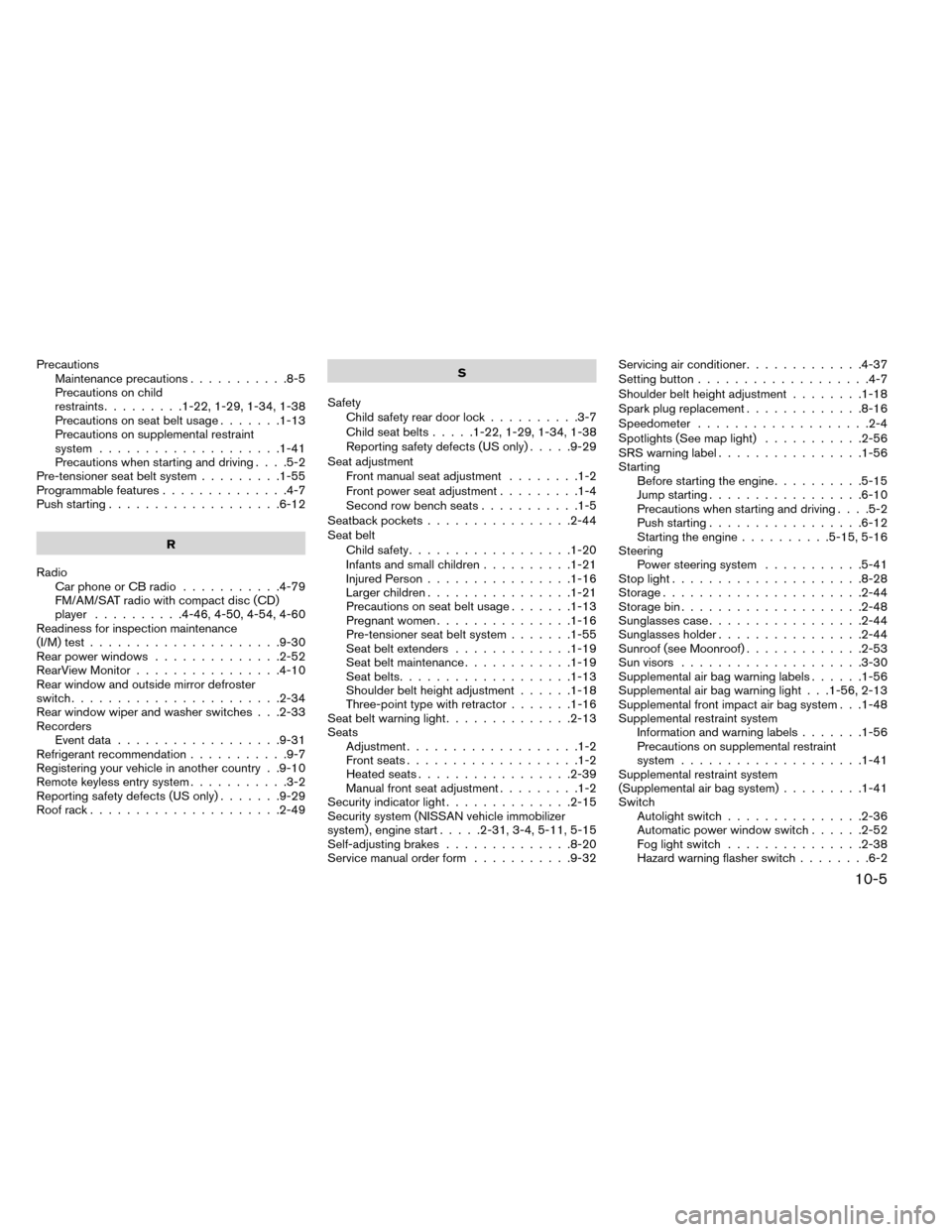
PrecautionsMaintenance precautions ...........8-5
Precautions on child
restraints.........1-22,1-29,1-34,1-38
Precautions on seat belt usage .......1-13
Precautions on supplemental restraint
system ....................1-41
Precautions when starting and driving ....5-2
Pre-tensioner seat belt system .........1-55
Programmable features ..............4-7
Push starting ...................6-12
R
Radio Car phone or CB radio ...........4-79
FM/AM/SAT radio with compact disc (CD)
player ..........4-46,4-50,4-54,4-60
Readiness for inspection maintenance
(I/M) test .....................9-30
Rear power windows ..............2-52
RearView Monitor ................4-10
Rear window and outside mirror defroster
switch.......................2-34
Rear window wiper and washer switches . . .2-33
Recorders Event data ..................9-31
Refrigerant recommendation ...........9-7
Registering your vehicle in another country . .9-10
Remote keyless entry system ...........3-2
Reporting safety defects (US only) .......9-29
Roof rack .....................2-49 S
Safety Child safety rear door lock ..........3-7
Child seat belts .....1-22,1-29,1-34,1-38
Reporting safety defects (US only) .....9-29
Seat adjustment Front manual seat adjustment ........1-2
Front power seat adjustment .........1-4
Second row bench seats ...........1-5
Seatback pockets ................2-44
Seat belt Childsafety..................1-20
Infants and small children ..........1-21
InjuredPerson................1-16
Largerchildren................1-21
Precautions on seat belt usage .......1-13
Pregnant women ...............1-16
Pre-tensioner seat belt system .......1-55
Seat belt extenders .............1-19
Seat belt maintenance ............1-19
Seat belts ...................1-13
Shoulder belt height adjustment ......1-18
Three-pointtypewithretractor.......1-16
Seat belt warning light ..............2-13
Seats Adjustment ...................1-2
Front seats ...................1-2
Heated seats .................2-39
Manual front seat adjustment .........1-2
Security indicator light ..............2-15
Security system (NISSAN vehicle immobilizer
system) , engine start .....2-31,3-4,5-11,5-15
Self-adjusting brakes ..............8-20
Service manual order form ...........9-32Servicing air conditioner
.............4-37
Setting button ...................4-7
Shoulder belt height adjustment ........1-18
Spark plug replacement .............8-16
Speedometer ...................2-4
S
potlights(Seemaplight) ...........2-56
SRS warning label ................1-56
Starting Before starting the engine ..........5-15
Jump starting .................6-10
Precautions when starting and driving ....5-2
Push starting .................6-12
Starting the engine ..........5-15,5-16
Steering Power steering system ...........5-41
Stoplight.....................8-28
Storage......................2-44
Storagebin....................2-48
Sunglasses case .................2-44
Sunglasses holder ................2-44
Sunroof (see Moonroof) .............2-53
Sunvisors ....................3-30
Supplemental air bag warning labels ......1-56
Supplemental air bag warning light . . .1-56, 2-13
Supplemental front impact air bag system . . .1-48
Supplemental restraint system Information and warning labels .......1-56
Precautions on supplemental restraint
system ....................1-41
Supplemental restraint system
(Supplemental air bag system) .........1-41
Switch Autolightswitch...............2-36
Automatic power window switch ......2-52
Foglightswitch ...............2-38
Hazard warning flasher switch ........6-2
10-5